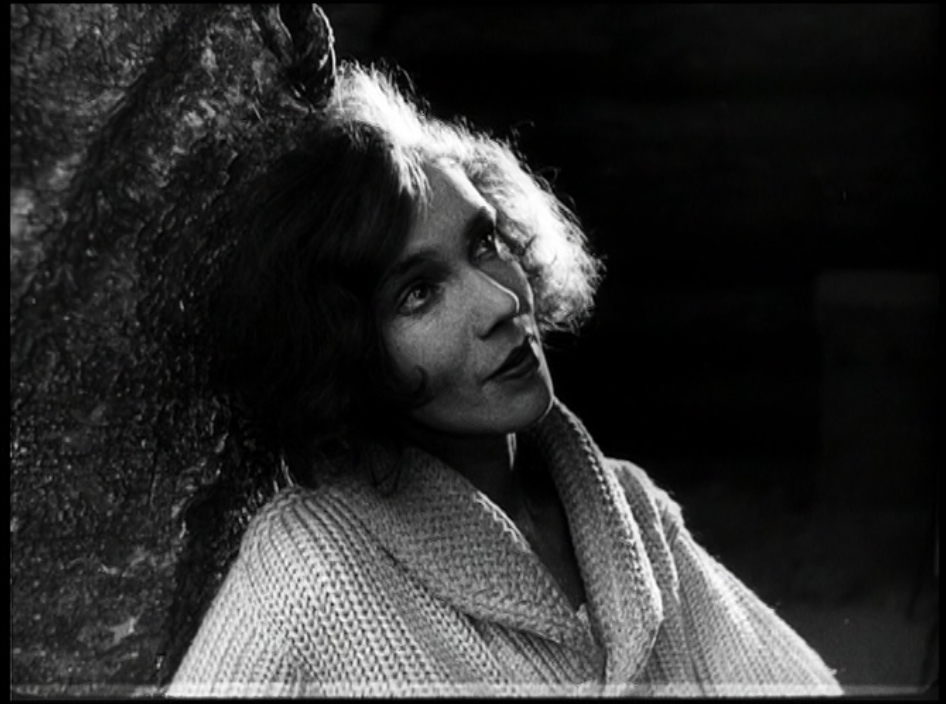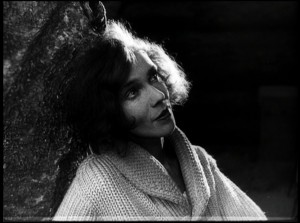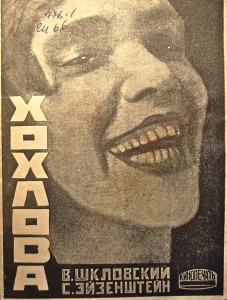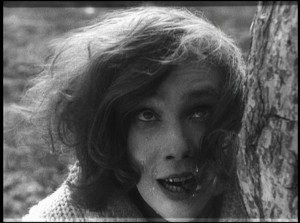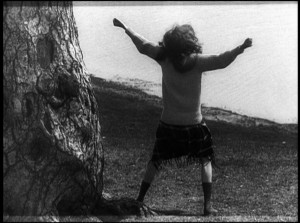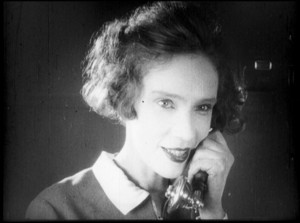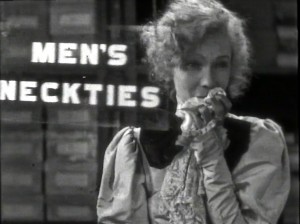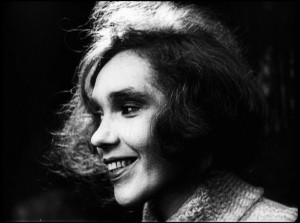Today Aleksandra Khokhlova is remembered as the star actress in films directed by Lev Kuleshov in the 1920s and 1930s. Indeed, at the peak of her career she was at the epicenter of the Soviet avant-garde, an icon of the experimental acting that matched the style of revolutionary montage cinema. Looking back at his life, Kuleshov wrote: “Nearly all that I have done in film directing, in teaching, and in life is connected to her [Khokhlova] in terms of ideas and art practice” (1946, 162). Yet, Khokhlova was much more than Kuleshov’s wife and muse as in her own right she was a talented author, actress, and film director, an artist in formation long before she met Kuleshov.
Growing up in an affluent intellectual family, Aleksandra would have had many inspiring artistic encounters. Her maternal grandfather, the merchant Pavel Tretyakov, founder of the Tretyakov Gallery in Moscow, was a philanthropist and patron who purchased and exhibited masterpieces of Russian Romanticism, Realism, and Symbolism. Aleksandra’s parents’ St. Petersburg home was a prestigious art salon and significant painters, actors, and musicians were family friends. Portraits of Aleksandra as a young girl were painted by such eminent artists as Valentin Serov and Filipp Maliavin. Aleksandra’s father, the doctor Sergei Botkin, an art connoisseur and collector, cultivated ties to the World of Arts circle–the creators of the Ballets Russes. Serge Diaghilev along with designer Leon Bakst, painter Alexandre Benois, and ballet dancers Tamara Karsavina and Vaslav Nijinsky appear in Botkin family photos (Botkina et al., 134-143, 155-159). In her memoirs, Aleksandra recalled the strange fascination of seeing those she knew from the intimate family circle on stage (Botkina et al., 56). Listening to conversations at the family table and watching splendid performances made Aleksandra privy to the secrets of stagecraft, and considering her close connection to the Ballets Russes as a new era in Modern dance performance, future researchers will no doubt evaluate their influence on Khokhlova’s experimental acting style and her worldview. Certainly her childhood exposure to theater instilled a passionate, selfless dedication to art–the kind of idealistic commitment typical of the early twentieth-century Russian intelligentsia. Later in her memoirs she wrote that working in cinema was for her “the most important thing in life” (Kuleshov and Khokhlova 1975, 62). Perhaps this commitment fortified her against the daunting challenges of Soviet state cinema work–from a drastic lack of resources to censorship and Party pressure.
As we learn from the memoirs, one more childhood influence reinforced an idealistic view of the actor’s profession–Konstantin Stanislavsky, director of the Moscow Art Theater and close friend of Aleksandra’s parents (1975, 54). Stanislavsky taught how to approach the actor’s work as a search for authenticity, for ways to convey the irreducible complexity of the character’s inner world. Alexandra’s relationship with the Stanislavsky school, however, is often overlooked because her career as a film actress evolved under the banner of Soviet avant-garde, which cut ties with established theater traditions. Yet, Kuleshov’s desire to revolutionize cinema was fueled by the same hatred of stage clichés and bad acting that compelled Stanislavsky to search for new forms in the theater. Echoing her husband’s disdain for the histrionic acting in film dramas of the past, Aleksandra wrote: “I absolutely agree with Stanislavsky, who said that the best film actors are animals; they move in a way that pertains to them–organically, naturally, truthfully, and therefore, artistically. A tiger onscreen walks just like a tiger…whereas people representing other people often come across as unnatural and non-artistic” (1975, 58).
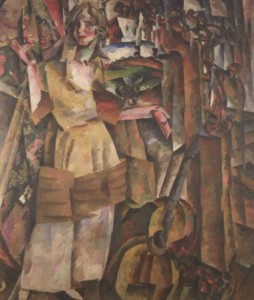
Aleksandra Khokhlova by Aristarkh Lentulov (1919). Courtesy of Wikimedia Commons.
Although Kuleshov shared this conviction, his approach to unconvincing acting was very different from Stanislavsky’s. While the theater maître emphasized subtle character movements growing from the everyday environment to gradually disclose inner states, Kuleshov expected actors’ movements to be athletic, visually impressive, and efficient in conveying plot. Remembering that Kuleshov’s avant-garde work used actors in a highly farcical, even grotesque stylization, it is no wonder that Stanislavsky is undetectable in Alexandra’s acting there. However, the question of her indebtedness to realist theater merits further research, especially considering that her best roles–Edith in By the Law (1926) and Dulcie in The Great Consoler (1933)–exhibit psychological depth that exceeds Kuleshov’s framework. Likewise, two fiction silent films that Khokhlova directed herself, The Affair of the Clasps (1929) and Sasha (1930), convey the nuances of characters’ inner worlds and reconstruct their daily lives. This work seems at odds with Kuleshov’s manifestoes of the early 1920s, situating her closer to realist theater traditions, and in this regard it is notable that eventually Kuleshov himself would come to embrace Stanislavsky’s method in his 1941 textbook for student filmmakers, Foundations of Film Directing/Osnovy kino-rezhissury, based on the couple’s joint work teaching film directing.
Beyond intimate knowledge of theater, Aleksandra’s acquaintance with the Stanislavsky family exposed her to other arts, and, together with her peer, Stanislavsky’s daughter Kira, she studied painting and grew interested in abstraction. The two girls were especially fascinated with the Moscow Kubo-Futurists and other fractions of the legendary association “Jack of Diamonds,” becoming friends with abstract painters Mikhail Larionov and Natalia Goncharova who designed sets for Aleksandr Tairov’s Chamber Theater where they attended many innovative stage productions (1975, 56).
In 1914, Aleksandra married her first husband, Konstantin Khokhlov, an actor in Stanislavsky’s Moscow Art Theater. At the time, Khokhlov was himself a rising film star, appearing in a number of successful melodramas, and it was in one of his films, (Uragan/Hurricane, directed by Boris Sushkevich), that Aleksandra made her debut as a supporting actress in 1916 (E. Khokhlova 2006, 4; 1975, 57; Fomin 2004, 201). The birth of Aleksandra’s son Sergei, Konstantin’s departure for World War I, the turmoil of the Revolution, and the Civil War explain the gap in Aleksandra’s cinematic career.
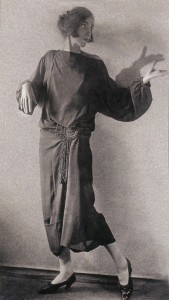
Aleksandra Khokhlova in a dance étude from “Kuleshov’s Effects.” Russian Heritage 2 (1993): 110-115.
In 1919, Aleksandra Khokhlova passed her entrance exams for the new State Institute of Cinematography in Moscow, the first professional institution of its kind in the world, testimony to the Bolshevik government’s commitment to cinema as a mass art. Despite official support and enthusiastic faculty, the Institute’s early study programs were unsystematic and poorly equipped, having neither cameras nor film stock available for pedagogical purposes. Moreover, the new professors did not always know how to teach the cinema, a young art and even younger academic discipline. Aleksandra’s major was film acting, but the schooling consisted of dance and movement exercises in which Aleksandra excelled, having studied under the Czech actress Běla Gorská. Looking back, however, Aleksandra reflects that “elementary theatrical techniques and symbolic gestures” she had learned from Gorská confined her acting to a set of clichés, and the poses she memorized were “examples of what not to do” (1975, 57). Unfortunately, the acting classes in the Institute itself were not much different, and teachers privileged the systems of François Delsarte and Emile Jaques-Dalcroze which gave students little to help develop their creative imaginations. Khokhlova recalls taking a course on acting taught by Olga Preobrazhenskaia and being disappointed that the studies went no further than dance and rhythmical movement (1975, 59).
The Institute opened a new chapter in Alexandra’s career, for there she met Lev Kuleshov–a young director determined to revolutionize the art of cinema, who was immediately struck with her: “They drew my attention to a tall, very rhythmical woman in an orange tunic, who was dancing in a circle of other young men and women…This was Khokhlova. And the tunic she wore was given to her by Isadora Duncan herself!” (1975, 45). The first project they collaborated on was Kuleshov’s semi-documentary On the Red Front (1920)–a film that combined actual footage from the Civil War with staged sequences, featuring Kuleshov and Khokhlova as Polish peasants.
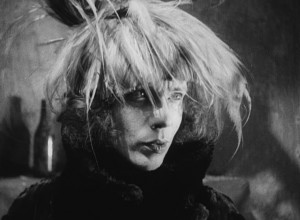
Aleksandra Khokhlova as the countess in The Extraordinary Adventures of Mr. West in the Land of the Bolsheviks (1924). Private Collection.
Upon their return to Moscow from the shooting trip in the provinces, Kuleshov put all his efforts into exploring the laws of cinematic expressivity. He believed that the power of cinema as an art lay in editing and dynamic action. These two elements became the object of his experiments conducted in collaboration with a group of students from the State Cinematographic School where Aleksandra Khokhlova became a main figure in the legendary “Kuleshov collective” along with Vsevolod Pudovkin, Vladimir Fogel, and Boris Barnet. Working under conditions of extreme poverty, Kuleshov’s troupe was at first unable to procure film stock so they concentrated on acting études, using a special rectangular frame with black velvet curtains to imitate the camera’s viewfinder (Kuleshov 1974; Kepley 1986; Kepley 1992; Olenina 2011). Kuleshov demanded extreme bodily mastery and geometrical precision of movement from his actors. Seeking to maximize the narrative value of each shot and increase the pace of cutting in his future film projects, Kuleshov trained his students to act in a series of discrete vivid and concrete motions. Mindful of shot composition, he insisted that actors plan how the vectors of their gestures would look onscreen, breaking down movements into elements and implementing rigorous exercises that taught his actors to turn and bend abruptly following set rhythmical patterns, evident in The Extraordinary Adventures of Mr. West in the Land of the Bolsheviks (1924) and The Ray of Death (1925). In these films, Kuleshov’s troupe intermixes trained expressions with grotesque buffoonery and eye-grabbing acrobatics modeled after American action films and circus stunts, these the daring physical spectacles that became known as “eccentric” acting. Here is Sergei Eisenstein’s 1926 encomium for Khokhlova, first female performer to embody this experimental style:
Khokhlova has, of course, a talent for acting that is perhaps the only one of its kind that is worthy of serious mention…America is possessed by the ideal of the petty-bourgeois “ Bathing Girl.” […] Khokhlova frustrates that ideal. The firm grip of her toothy grin shreds the hackneyed formula of ‘the woman of the screen = the woman of the bedroom.’ […] Khokhlova can create an entirely new genre…Khokhlova has to be provided with sharply Soviet roles and a proper interpretation to match her essential qualities. Firmly rejecting demonic women, adventuresses and the rest, I would plait her hair, dress her in a sarafan and release a cycle of grotesque comedies on a “town and country” theme with a screen’s first female eccentric–Khokhlova… (2010, 71-72).
Eisenstein saw gags and stunts, characteristic of eccentric acting, as “attractions” that smashed the conventions of the bourgeois theater with its voyeuristic pleasures. For him, Khokhlova’s eccentricities not only challenged the stereotypical female roles in cinema but promoted a more active and critically engaged viewing experience.
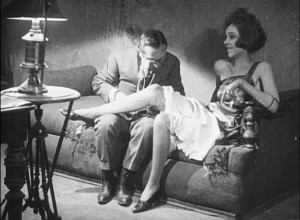
Aleksandra Khokhlova in The Extraordinary Adventures of Mr. West in the Land of the Bolsheviks (1924). Private Collection.
Other contemporaries emphasized a different side of Khokhlova’s acting, especially after By the Law (1926) when it became apparent that she brought remarkable psychological nuance and emotional power to her roles. Formalist literary scholar and scriptwriter Viktor Shklovskii wrote in 1926 that Kuleshov had thus far failed to find suitable roles for his wife: his penchant for eccentric performances blinded him to her talent as a tragic actress (14). American Imagist poet H.D. (Hilda Doolittle) noted Khokhlova’s conveyance of extreme psychological states in the execution and burial scenes in By the Law, writing in 1928 in the British journal Close-up:
A girl, a child with incredibly thin legs, hurled herself on the ice and snow crusted bad earth, clung to it, like some wan and exquisite Persephone, crying to be buried, dragged in, taken back and back away from human consciousness…The gestures of this woman are angular, bird-like, claw-like, skeleton-like and hideous. She has a way of standing against a sky line that makes a hieroglyph, that spells almost visibly some message of cryptic symbolism. Her gestures are magnificent. If this is Russian, then I am Russian. Beauty is too facile a word to discuss this; this woman is a sort of bleak young sorceress, vibrant, febrile, neurotic, as I say, cataleptic. …. Her face can be termed beautiful in the same way that dawn can be beautiful rising across stench and fever of battle… there is no word for such things. Her mind, her soul, her body, her spirit, her being, all vibrate, as I say, almost audibly. If this is Russian then I am Russian (1998, 126-127).
H.D.’s London review, virtually unknown in Russia, might have appeared too philosophical for Khokhlova’s politically-minded compatriots. Yet Khokhlova had allies among Russian avant-garde artists and leftist intellectuals, and she and Kuleshov had close ties with the Left Front of the Arts–Vladimir Mayakovsky, Lili and Osip Brik, Nikolai Aseev, Viktor Shklovsky, Esfir Shub, Aleksei Gan, and Aleksandr Rodchenko and his wife Varvara Stepanova.
Despite important connections and critical acclaim, Khokhlova fell out of favor with Soviet film industry authorities, and after By the Law when Kuleshov proposed new projects he found himself under pressure not to cast Khokhlova, because of her non-proletarian descent. Khokhlova’s uncle, personal doctor to the Czar’s family, followed Nicholas II into exile and was executed alongside his royal patients. But the official rejection stated that Khokhlova was not “not beautiful enough” for the screen and looked “emaciated” (1975, 90). In response to these accusations, many intellectuals defended Khokhlova’s right to the screen (1975, 108). Eisenstein, infuriated, argued that “artistic councils of the studios look at a woman through the eyes of a primeval cattle-breeder” (2010, 71). Osip Brik responded by writing a motion picture play script specifically for Khokhlova, entitled Cleopatra (Brik 2003).
But all these efforts failed and Khokhlova would star in only two more Kuleshov films–Your Acquaintance, or The Journalist (1927) and The Great Consoler (1933), the last of which offers a bitter commentary on the situation unfolding in her life off-screen. Khokhlova’s heroine, Dulcie, fired from a department store because she is “too thin” and “not pretty enough” for the counter, wipes her tears as a glowing advertisement for “Men’s Neckties” swings before her face.
Surprising as it may seem, although Khokhlova was prevented from acting, in the late 1920s she was allowed to direct her own films, although she had to find her own producer (1975, 122). Eventually, the Sovkino Studio accepted her idea for an adaptation of Maxim Gorky’s story “An Affair of the Clasps” on condition that she obtain Gorky’s approval which she did by promising to employ realist acting techniques (1975, 123). Set in the 1890’s, Gorky’s story exposes the bigotry and hypocrisy of a small town matron as she mistreats the tramps hired for work on her estate. Every day, she reads the Bible to them, pretending to shepherd their souls, but her actual motive is to cut down their wages to make up for unplanned “rest” time. As the cheated workers retreat to their quarters, one of them shows the others the silver book clasps that he ripped off the matron’s Bible in revenge. Another young tramp buys the clasps with his meager savings and returns them to the lady, only to encounter her anger and dismay. Khokhlova represents these events using a mixture of nineteenth-century realism in the vein of Tolstoy and Chekhov and Kuleshov’s anti-realism. Kuleshov’s lessons in analytical editing and the rhetorical power of montage is there in a scene that creates an ironic perspective on the matron: multiple shots of her zealously kissing relics in church, are intercut with images of tired workers waiting outside. A sarcastic title card comments “The lady is accumulating sanctitude.” In another scene, Khokhlova’s montage juxtaposes an angry conversation between the matron and her workers with shots of a boiling pot of jam, the steaming liquid becoming a metaphor for escalating tension, as a boiling kettle works in By the Law. Although these formal devices align Khokhlova with avant-garde directors Dziga Vertov and Shub, An Affair of the Clasps (1929) differs from 1920s Soviet production in the genuine interest shown to the characters by lingering on their imperfect yet beautiful faces and savoring the weathered, dusty textures of their clothes. Her elusive close-ups suggest the enigmatic complexity of the person’s inner world instead of emphasizing a single emotion in the style of Kuleshov. An Affair of the Clasps thus presents characters with more sympathy and humanity than Soviet films committed to agit-prop clarity.
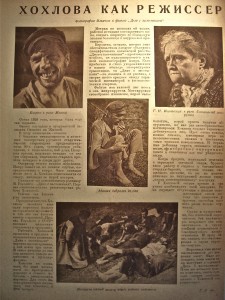
Sovetskii Ekran [The Soviet Screen], “Khokhlova as a film director.” Rev. of An Affair of the Clasps (1929). Private Collection.
Khokhlova’s last independent project as a filmmaker was a kulturfilm about wooden toys made by Russian folk craftsmen. Entitled Toys (1931), this film presented the evolution of toys from archaic times to the present day. In her memoirs, Khokhlova recalls that she invited boys and girls from an itinerant gypsy camp stationed near Moscow to perform the role of prehistoric children (1975, 128). Though critical reviews of Khokhlova’s films were generally positive, she received no further commissions although her name appears in the credits for several Kuleshov films made in the 1930s and 1940s as “assistant director.” The films of the 1940’s were Socialist Realist projects that Kuleshov had no choice but to accept, and some were unfinished works botched by other filmmakers that Kuleshov was charged with “rescuing.” As Khoklova’s granddaughter, the film scholar Ekaterina Khokhlova, characterized them, these adventure stories for adolescents had little artistic value (Olenina 2008). Besides her work in cinema Khokhlova’s life was dedicated to teaching film directing and acting at the VGIK–the All-Russian State Institute of Cinematography in Moscow. Together with Kuleshov she wrote a book of memoirs, 50 Let v. Kino or 50 Years in Cinema, and after her husband’s death, she served as general editor of his Collected Works.
See also: Esfir Shub

